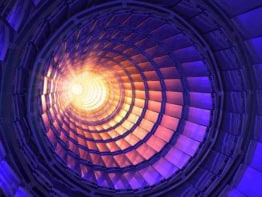Physicists at the DESY laboratory in Germany have detected the first "pentaquark" to contain a charm quark. The H1 collaboration has found evidence for a charmed pentaquark with a mass of 3099 MeV in electron-proton collisions at the HERA accelerator. However, the ZEUS experiment at HERA has not been able to confirm the observation (arXiv.org/abs/hep-ex/0403017).
Quarks and antiquarks come in six different flavours – up, down, strange, charm, bottom and top – and normally combine in twos and threes to form other particles. Mesons contain a quark and an antiquark, while baryons contain three quarks or three antiquarks. The proton, for instance, contains two up quarks and a down quark, whereas a negative kaon contains a strange quark and an up antiquark.
Last year, however, evidence emerged for two new particles made of four quarks – the Ds(2317) and the X(3872) – and for a third new particle containing five quarks. This pentaquark contained two up quarks, two down quarks and a strange anti-quark, and led theorists to predict that other pentaquarks containing heavier quarks – such as the charm quark – could exist. Such particles may now have been seen in collisions between protons and electrons at the Hadron-Electron Ring Accelerator (HERA) in Hamburg.
The H1 team at HERA detected events in which the electron-proton collisions produced an excited D– meson (which contains a down quark and a charm antiquark) and a proton, or their antiparticles. When the number of such events is plotted as a function of the collision energy, there is a narrow peak at 3099 MeV. This peak corresponds to the creation of a particle that contains two up quarks, two down quarks and a charm antiquark, or the equivalent antiparticle.
Both the HERA and ZEUS teams plan to do further experiments in an effort to confirm the observation. Experimental measurements of pentaquarks will provide new insights into the strong force that binds quarks together.



